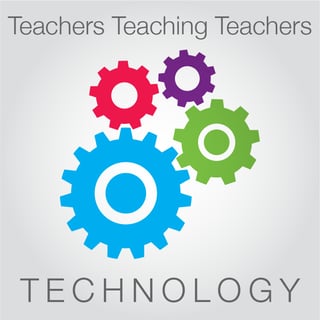 Building a T4PD Community, Part 2
Building a T4PD Community, Part 2
Last week’s blog, “Building a T4PD Community: Part 1,” described a new strategy for professional development that has helped one school transform into a 21st century learning center. Working one-on-one or in small groups, teachers come together to share their expertise in a supportive environment. This week, learn how you can institute the T4PD model in your school.
Getting Started with T4PD
Building a T4PD technology integration model in your school is easy – but it does take time. For two years our staff has been working to transform our classrooms with instructional technology, and we still have a ways to go to achieve full implementation.
Within the T4PD model, each member of the staff assumes one or more of the roles described below. While the process appears to result in a hierarchy, the foundation is based on a community of teachers assisting one another in a casual setting for the better implementation of instructional technology. Furthermore, teachers who take part in a T4PD model may actually fill several roles as the process continues and their ability to use technology in the classroom grows.
Within your T4PD community, you may find teachers to fill some of the roles described below:
 The “Innovator”
The “Innovator”
The T4PD process typically begins with a teacher or teachers who have mastered the skills necessary to use technology as an effective teaching tool, and who are willing to collaborate with their fellow staff. These teachers are known as the “innovators.”
Teachers who act as the innovators typically have a robust background in instructional technology. They are usually first adopters of new technologies within their buildings. Innovators are teachers who likely teach each day at the redefinition level within the SAMR model. Their students use technology to obtain information, collaborate with others, create their own digital content, and share their content within the curriculum. These teachers continually find new and innovative ways to use instructional technology within their curriculum.
The most important trait of innovators is a willingness to share their skills and strategies with their colleagues. The innovator is a building leader in classroom technology, but is not an administrator. An innovator volunteers to help provide other teachers with technology training that is outside of the administrative in-services. Innovators might begin the T4PD process in their school by demonstrating a technology or strategy they have used with a fellow educator. From there, the process may continue to grow.
The T4PD process can also begin when another member of the teaching staff asks the innovator for assistance. As a classroom teacher who has been using educational technology for more than 15 years, I was happy to become my building’s innovator. I welcomed the opportunity to share and assist my fellow teachers in creating a 21st century school.
 The “Inquisitor”
The “Inquisitor”
Yes, the inquisitor sounds like another Star Wars character. However, the term describes the next role in the T4PD model perfectly. The inquisitor is a staff member who is highly interested in using more instructional technology within his or her curriculum, but is not sure where to begin. The inquisitor may have some technology skills, but is eager to learn even more about how to use technology as an instructional tool. As the name suggests, inquisitors ask countless questions about how to use instructional technology in their classrooms. They engage enthusiastically in technology exchanges with the innovator in order to learn new skills and strategies. An innovator may recruit an inquisitor, or the inquisitor may approach the innovator with questions about new skills and strategies that interest him or her. Inquisitors often ask to observe the innovator’s lessons in order to gather ideas and new techniques for their own curriculum.
The T4PD model typically begins with a series of technology exchanges in order to assist the inquisitor in implementing more instructional technology. Most of these technology exchanges are brief discussions and demonstrations during a planning period or after school. During these technology exchanges, the skill set and knowledge base of the inquisitor dramatically increases. The innovator shares not only technology skills, but also explains how the technology can be used to transform and redefine their classroom based on the SAMR model. The innovator works as a peer who supports the inquisitor and helps transform traditional lessons within the curriculum into 21st century, technology-based activities. After the technology exchange, the inquisitor is then able to undertake the new approach, and at the next technology exchange, any irregularities can be refined.
In my building, we began the T4PD process when a second-year teacher sought my assistance in using his classroom technology more effectively. My inquisitor had many questions about instructional technology and was eager to raise the level of SAMR in his classroom. He was searching for a way to create interactive content and conduct effective assessment activities. We began our T4PD process when I sat down one day to share some of the various features found within MimioStudio™ software. Over the course of several months, we met frequently and informally in order to share more instructional technology strategies and refinements. Following each of these technology exchanges, my inquisitor was able to apply these new skills successfully within his curriculum.
 “Our Community”
“Our Community”
As their success with the technology exchanges continues, both the innovator and the inquisitor will begin to share their success stories with the other teachers in their building. They will begin to subtly share and trumpet technology terms, strategies, skills, and resources with other teachers throughout the building. These might be shared via email or posted in the staff room. Let me emphasize that this sharing should all be staff-directed – not put forth by building or district administrators.
In our building, we had a lot of success with a “Tech Tip of the Day” that highlighted a simple yet effective way to use technology in a lesson. For example, one day we shared “5 Fun Things Students Can Do with the Mimio Highlighter Tool.”
At first some members of the staff were resistant to using technology in the classroom. But over time, the stream of useful Tech Tips increased interest among many of our peers. Teachers began trying some of these tips, with great success. That success translated into more and more interest in educational technology. As time went on, teachers began to feel comfortable having their own conversations about how they were using the Tech Tips in their classrooms. With interest peaking, we began to invite other teachers to our technology exchanges. The fact that the professional development was coming from their fellow teachers and not from administration also encouraged teachers to participate in technology exchanges.
Our technology exchanges were very informal and usually included donuts or candy to sweeten their appeal. Before long, several technology exchanges were taking place in our building on a weekly basis. As more time passed, teachers began to build a strong sense of community within the technology exchanges. Teachers who participated in the exchanges began to appreciate their fellow staff members more and feel connected by the use of instructional technology. What they learned in the exchanges was relevant to their teaching and wasn’t overwhelming. Much like new technology, the process continues to grow and evolve daily. Many teachers within our community have advanced into the innovator position, and even more teachers have begun to participate in technology exchanges.
The Added Bonus
The goal of creating a 21st century school has had the added bonus of fostering a greater sense of community among our teachers. That sense of community has grown over the past two years and continues to grow each day. The two-fold result is a teaching staff that trusts and appreciates one another, and a more effective use of instructional technology for our students.
Want to connect with your fellow educators? Join the MimioConnect® online community to share and exchange ideas on teaching, technology, and lessons.



